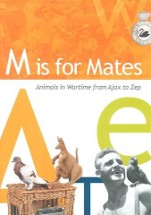M is for mates

Department of Veteran's Affairs and the Australian War Memorial,
2009. ISBN 978 1 877007 39 2.
(Ages: 7+) Highly recommended. Animals in war. Subtitled, Animals in
wartime from Ajax to Zep, this alphabet book will keep many readers
involved and intrigued. For the classroom however, it is
exceptional, giving loads of information about the group of animals
on the page, plus photos, pictures, maps, riddles and questions to
ponder. A number of the letters are used for specific animal
groupings, eg Koalas and Kangaroos, Insects, Horses and Dogs, while
others are used for general headings such as Uniform, Explosives,
Jungle and so on.
But whatever page is dipped into this brightly produced, award
winning book, it holds fascinating information, well set out and
designed.
I love the Insect page, for example, with paragraphs about the
insects which invaded our troops from Egypt to Rwanda, New Guinea to
Gallipoli. The various methods of ridding both themselves and their
uniforms of the uninvited guests is engrossing. Many animals and
birds are shown on the M is for mascots and mates pages, where a
kitten, kangaroo, donkey, duck and even a possum are shown with the
soldiers. And N stands for Navy cats, a double page to themselves.
Possibly one of the saddest pages is that for Q. Standing for
quarantine, it reminds us that many animals did not make it home,
the quarantine laws making it impossible. So most of the horses,
admired for their courage and bravery in South Africa and Palestine
were left behind, as were the tracking dogs in Vietnam. Happily now,
animals are brought back to Australia when their job is done.
This excellent book has a double page map in the centre which shows
where animals served overseas, and the whole book is served by an
informative glossary, list of websites for further reading and a
crossword and list of questions. And the time line which runs across
the bottom of every page is most helpful.
Fran Knight